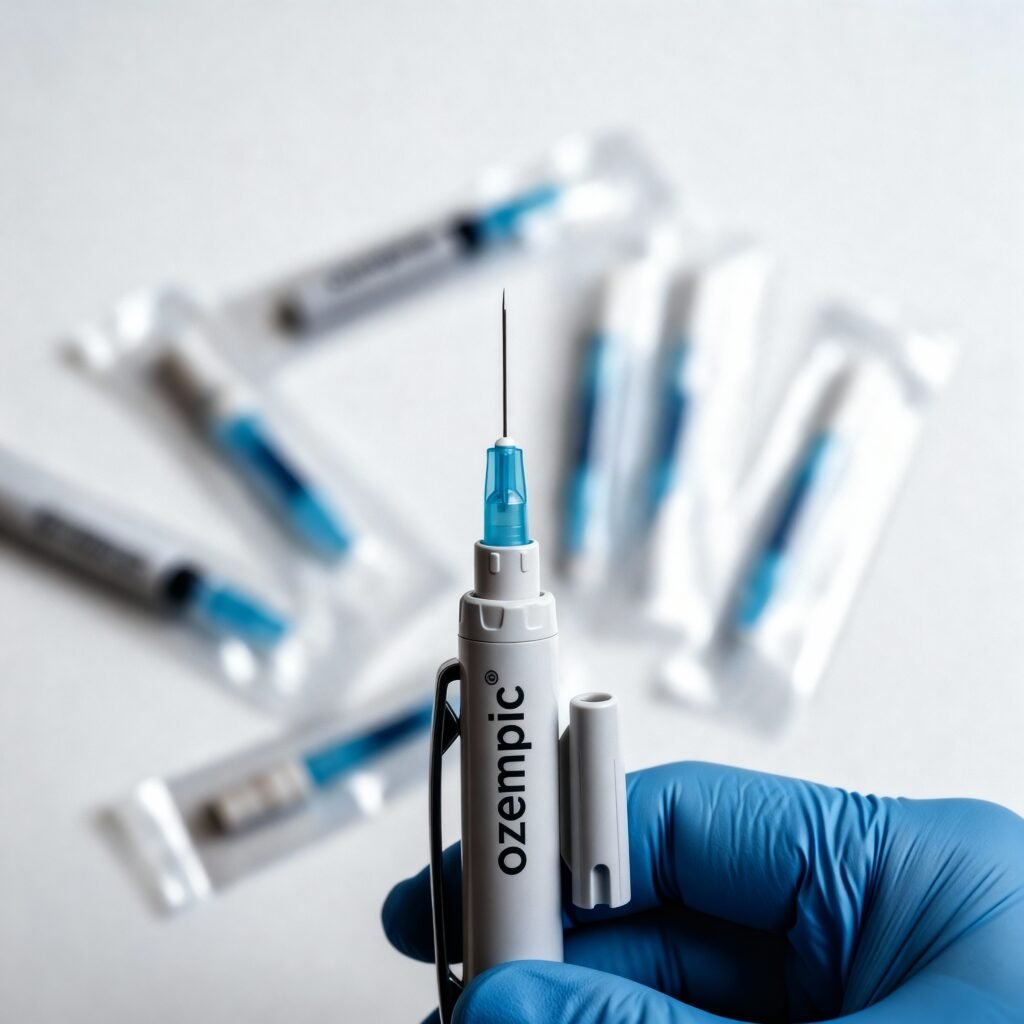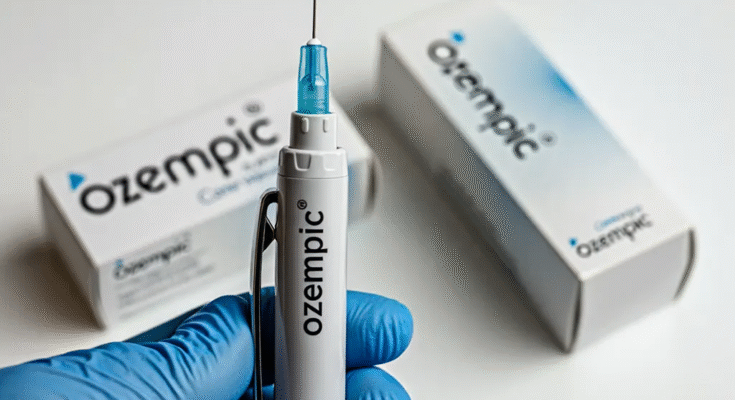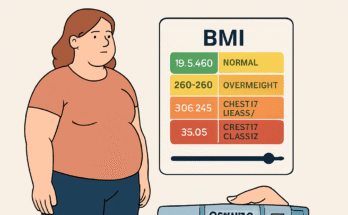If you’re using Ozempic for type 2 diabetes management or weight loss, understanding how to obtain replacement needles is essential for maintaining your treatment routine. Many patients wonder whether they can buy Ozempic needles separately and where to find compatible injection supplies. This comprehensive guide covers everything you need to know about purchasing pen needles, compatibility options, and best practices for safe medication administration.
Understanding Ozempic Injection Supplies
Ozempic (semaglutide) is a once-weekly GLP-1 receptor agonist prescribed for blood sugar control and weight management. The medication comes in a pre-filled injection pen designed for subcutaneous administration. While the pen contains the medication, understanding the needle supply situation is crucial for uninterrupted treatment.
The needle inclusion policy varies depending on your location and the specific Ozempic dosage pen you receive. In the United States, Ozempic pens typically do not include needles in the package. You must obtain compatible pen needles separately from your pharmacy or medical supply provider.
Canadian patients may experience different packaging. Certain Ozempic 0.25 mg/0.5 mg packs include six disposable needles in the carton, providing initial supplies for starting treatment. However, regardless of location, most patients eventually need to purchase additional needles to maintain their weekly injection schedule.
The standard Ozempic pens come in different dosage strengths, and needle requirements vary accordingly. Understanding your specific pen type helps ensure you order the correct quantity of replacement needles for your treatment duration.
Where to Buy Replacement Pen Needles

Finding compatible needles for your Ozempic pen is straightforward once you know where to look. Multiple purchasing options exist, ranging from traditional pharmacies to online retailers.
Most neighborhood pharmacies stock universal fit pen needles that work with Ozempic injection devices. Major pharmacy chains, including CVS, Walgreens, and Rite Aid, carry various brands and sizes of pen needles. These establishments typically maintain an inventory of popular sizes like 32-gauge 4mm needles, which are commonly recommended for GLP-1 medications.
When visiting your local pharmacy, you can request pen needles without providing your prescription in many states. However, some states require a prescription for needle purchases, so checking your local regulations beforehand can save time. Pharmacy staff can help you identify compatible needles and answer questions about gauge sizes and needle lengths.
Online shopping provides convenience and often better pricing for pen needle supplies. Reputable websites like Amazon, medical supply distributors, and diabetes care specialists offer bulk purchasing options. Online retailers typically stock multiple brands, including NovoFine, BD Ultra-Fine, and generic alternatives.
Purchasing needles online allows you to compare prices, read customer reviews, and often subscribe for automatic deliveries. This subscription approach ensures you never run out of essential injection supplies between pharmacy visits.
Novo Nordisk, the pharmaceutical company that manufactures Ozempic, produces NovoFine needles specifically designed for their injection pens. While these needles work excellently with Ozempic, universal fit alternatives from other manufacturers also provide reliable performance. Many healthcare providers offer samples or can direct you to patient assistance programs that may help with needle costs.
Understanding Needle Compatibility
Not all injection needles work with every pen device, making compatibility knowledge essential. Fortunately, most pen needles sold in the United States follow universal standards that fit Ozempic pens.
The majority of modern pen needles utilize a universal screw-on design compatible with various injection pen brands. This standardization means you’re not limited to one specific needle brand when using Ozempic. Any pen needle marked as “universal fit” or compatible with Type A pen injectors should work with your Ozempic pen.
Novo Nordisk recommends NovoFine Plus 32G 4mm needles as optimal for Ozempic administration. These represent the thinnest available needles for GLP-1 receptor agonists, offering comfortable injections while ensuring proper subcutaneous delivery. The 32-gauge measurement indicates needle thickness, while the 4mm specification refers to needle length.
These shorter, finer needles reach the subcutaneous fat layer effectively for most adults while minimizing discomfort and reducing the risk of intramuscular injection. Clinical research supports that 4mm needles work safely for patients across different body mass index categories.
Needle Size Selection Guide
Choosing appropriate needle dimensions significantly impacts your injection experience and medication effectiveness. Understanding gauge numbers and length options helps you make informed decisions.
Gauge refers to needle thickness, with higher numbers indicating thinner needles. Pen needles typically range from 29 to 33 gauge. Thinner needles (higher gauge numbers) cause less pain during insertion but may require slightly more time for medication delivery.
Common gauge options include 29-gauge for thicker options with faster medication flow, 31-gauge for medium thickness balancing comfort and speed, 32-gauge for thin needles reducing injection discomfort, and 33-gauge for ultra-thin maximum comfort.
Most diabetes care providers recommend 31 to 32-gauge needles for GLP-1 medications like Ozempic. These sizes provide excellent comfort while ensuring reliable medication administration.
Pen needles come in lengths ranging from 4mm to 12.7mm. Medical guidelines increasingly favor shorter needles for subcutaneous injections. The International Scientific Advisory Board recommends 4mm, 5mm, and 6mm needles for all adult patients regardless of body size.
Shorter needles offer several advantages, including reduced injection anxiety due to less intimidating appearance, lower risk of intramuscular injection, decreased pain and discomfort, and easier injection technique without requiring skin pinching.
For most adults using Ozempic, 4mm or 5mm needles provide optimal results. These shorter lengths effectively reach the subcutaneous layer, where semaglutide should be deposited for proper absorption.
Cost Considerations for Pen Needles
Understanding needle pricing helps you budget for ongoing diabetes or weight management treatment. Costs vary based on brand, quantity, and purchase location.
Pen needles are generally affordable, especially when purchased in bulk. A box of 100 needles typically costs between $15 and $40, depending on the brand and retailer. Generic options often provide significant savings compared to name-brand alternatives without compromising quality.
Many pharmacies offer store-brand pen needles at competitive prices. These generic versions meet the same quality standards as branded products while reducing out-of-pocket expenses. For patients administering weekly Ozempic injections, a 100-count box provides approximately two years of supplies.
Health insurance plans vary in their coverage of pen needles. Some plans include needles as part of diabetes supplies coverage, while others may require separate authorization. Contact your insurance provider to understand your specific coverage and any applicable copayments.
Patients without insurance coverage or those seeking cost savings can explore several options. Many retailers offer loyalty programs or discount cards that reduce needle prices. Additionally, purchasing larger quantities typically lowers the per-needle cost.
Proper Needle Storage and Handling
Maintaining needle quality ensures safe, comfortable injections throughout your treatment. Proper storage practices prevent contamination and preserve needle sharpness.
Store unused pen needles in their original packaging in a cool, dry location away from direct sunlight and moisture. Avoid exposing needles to extreme temperatures, which could affect the protective coating and compromise sterility. Room temperature storage in a medicine cabinet or drawer works perfectly for most households.
Keep needles away from children and pets by storing them in a secure location. The small size of pen needles presents a potential safety hazard if accessed by curious youngsters.
Always inspect needle packaging before use. Damaged or opened packaging may indicate compromised sterility. If you notice any packaging defects, discard the needle and use a fresh one from an intact package.
Use each needle only once, then dispose of it properly in a sharps container. Reusing needles dulls the sharp tip, increasing injection pain and potentially affecting medication delivery. Single-use practice also reduces infection risk by preventing bacterial contamination.
Injection Technique Tips
Proper injection technique maximizes Ozempic effectiveness while minimizing discomfort. Following recommended practices ensures consistent medication absorption.
Before attaching a new needle, inspect your Ozempic pen to ensure the medication appears clear and colorless. Check the expiration date and dose counter. Wash your hands thoroughly with soap and water to reduce infection risk.
Attach a new needle by removing the protective tab and screwing it clockwise onto the pen until secure. Remove both the outer and inner needle caps, setting the outer cap aside for later disposal preparation.
Ozempic should be injected subcutaneously into your abdomen, thigh, or upper arm. Rotating injection sites prevents lipodystrophy, a condition where fatty tissue under the skin changes due to repeated injections in the same spot. Create a rotation pattern that ensures you don’t inject into the same exact location for at least four weeks.
Clean the injection site with an alcohol wipe and allow it to dry completely. Inserting a needle through wet alcohol can cause stinging and increase discomfort.
For most patients using 4mm or 5mm needles, skin pinching is unnecessary. Simply hold the pen at a 90-degree angle to your skin and insert the needle with a quick, confident motion. Press and hold the dose button until the dose counter returns to zero, then continue holding for six seconds to ensure complete medication delivery.
After the six-second count, withdraw the needle and dispose of it immediately in your sharps container. Never recap used needles, as this increases the risk of accidental needle sticks.
Safety and Disposal Guidelines
Responsible needle disposal protects household members, sanitation workers, and the environment from potential injury or contamination.
Invest in an FDA-approved sharps container specifically designed for needle disposal. These puncture-resistant containers prevent accidental needle sticks and safely contain used injection supplies. You can purchase sharps containers at pharmacies, medical supply stores, or online retailers.
If a commercial sharps container isn’t immediately available, use a sturdy plastic container with a screw-on lid as a temporary solution. Laundry detergent bottles or bleach containers work well. Clearly label any improvised container as “sharps” or “biohazard” to alert others to the contents.
Never throw loose needles directly into household trash. This dangerous practice puts sanitation workers and others at risk of needle stick injuries. Always place used needles in your sharps container immediately after injection.
When your sharps container reaches the fill line (typically about three-quarters full), seal it according to the manufacturer’s instructions. Contact your local waste management authority or pharmacy to learn about approved disposal options in your area. Many communities offer sharps collection programs, mail-back services, or designated drop-off locations.
Troubleshooting Common Needle Issues
Understanding potential needle-related problems helps you maintain consistent treatment without interruption.
Occasionally, needles may become blocked or bent during use. If you experience resistance when pressing the dose button, don’t force it. Remove the needle and inspect it for visible damage. Replace it with a fresh needle and attempt your injection again.
Bent needles typically result from improper insertion technique or hitting a resistant tissue area. Using quick, confident insertion motion usually prevents bending issues.
If you notice medication leaking from the needle after injection, you may not have held the pen in place long enough after dose delivery. Remember to count to six slowly after the dose counter reaches zero before withdrawing the needle. This waiting period ensures complete medication delivery and prevents wastage.
While some minor discomfort is normal with any injection, excessive pain may indicate several issues. Ensure you’re using an appropriate needle length and gauge for your body type. Consider switching to a thinner needle if you experience significant discomfort.
Rotating injection sites and avoiding areas with scar tissue, moles, or skin abnormalities also reduces discomfort. If pain persists despite following proper technique, consult your healthcare provider for personalized guidance.
Traveling With Ozempic and Needles
Maintaining your treatment schedule while traveling requires preparation and understanding of transportation regulations.
When traveling by air, pack your Ozempic pen and needles in your carry-on luggage rather than checked bags. Temperature fluctuations in cargo holds could affect medication stability. Bring extra needles beyond what you expect to need, accounting for potential trip extensions or lost supplies.
Carry documentation from your healthcare provider confirming your need for injectable medication. While not always required, this letter can expedite security screening and prevent questions about carrying needles and medication.
Transportation Security Administration (TSA) regulations permit injectable medications and associated supplies in carry-on bags. Inform security officers that you’re carrying medical supplies when you reach the checkpoint. You shouldn’t encounter problems, but being upfront prevents delays.
Keep needles in their original packaging when possible to clearly identify them as medical supplies. Loose needles without context might raise questions during security screening.
Alternative Needle Brands and Options
While Novo Nordisk produces NovoFine needles specifically for their pens, numerous alternative brands offer excellent quality and value.
Becton Dickinson (BD) manufactures highly regarded pen needles used by millions of diabetes patients worldwide. BD Ultra-Fine needles feature a special coating that reduces injection discomfort and come in various gauge and length combinations. These needles use a universal fit design, making them fully compatible with Ozempic pens.
Major pharmacy chains offer their own branded pen needles at competitive prices. CVS, Walgreens, and Walmart all produce quality generic alternatives to name-brand needles. These store-brand options meet the same safety and quality standards while providing significant cost savings.
Several specialized manufacturers focus exclusively on injection supplies. Brands like Pip, Comfort Point, and Easy Touch offer needle options with unique features like comfort coatings, ultra-thin wall technology for faster flow, and ergonomic hub designs. While these specialty brands may cost slightly more, some patients find their features worth the investment.
Consulting Your Healthcare Provider
Your diabetes care team serves as your best resource for personalized needle selection and injection technique guidance.
Schedule a consultation with your healthcare provider if you experience persistent injection pain, notice skin changes at injection sites, or have questions about needle selection. Providers can demonstrate proper technique, recommend specific products, and address any concerns affecting your treatment compliance.
Some medical practices and diabetes education centers offer injection training sessions where you can practice technique under professional supervision. Taking advantage of these resources builds confidence and ensures you’re maximizing your medication’s effectiveness.
If needle costs create financial hardship, discuss this openly with your provider. They may know about patient assistance programs, manufacturer coupons, or generic alternatives that reduce expenses. Some medical offices also provide needle samples that can bridge gaps between prescription refills.
Conclusion
Purchasing Ozempic needles separately is not only possible but necessary for most patients in the United States. Understanding your options for obtaining compatible pen needles ensures uninterrupted treatment while potentially reducing costs through smart shopping. Whether you choose brand-name NovoFine needles or generic alternatives, focusing on appropriate gauge and length specifications ensures comfortable, effective injections.
Remember that proper needle selection, storage, and disposal practices contribute to successful diabetes management or weight loss treatment. By following the guidelines in this comprehensive guide, you can confidently maintain your Ozempic regimen with the right injection supplies for your individual needs.

Lisa Caldwell is a clinical health writer and certified diabetes educator with a strong background in pharmacology and metabolic health. With over 12 years of experience in patient education, she specializes in translating complex research on GLP-1 medications like Ozempic into clear, practical guidance.




